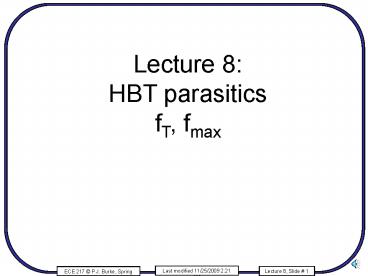Lecture 8: HBT parasitics fT, fmax - PowerPoint PPT Presentation
1 / 33
Title: Lecture 8: HBT parasitics fT, fmax
1
Lecture 8 HBT parasitics fT, fmax
2
HW
- Degenerate semiconductors
- Sign error 1.7 f liberal partial credit
3
AC equivalent circuit
If we are only interested in ac components, life
can be simplified
VCC
Rc
Hybrid p model
Discuss easy interpretation of p model.
4
General admittance matrix
Last lecture, we had emitter grounded. Called
common emitter configuration
In general
Y-matrix has 9 elements, but once you know 4 you
know them all because
and
See book about details procedure to get 9
parameters from only 4.
5
General impedance matrix
Y-matrix has 9 elements, but once you know 4 you
know them all because
6
h matrix
Common emitter 1base, 2collector Common base
1emitter, 2collector Common collector 1base,
2 emitter
Note In general, matrix elements depend on dc
currents, dc voltages, and frequency. Spec. sheet
(or model) will provide the matrix elements as a
table vs. frequency, usually for only one bias
current.
7
ABCD matrix
Common emitter 1base, 2collector Common base
1emitter, 2collector Common collector 1base,
2 emitter
8
Common-Emitter AC equivalent circuit
VCC
Rc
Hybrid p model Red is new for ac
- Circuit model good only for low frequencies
- At high frequencies computer must be used!
9
Hybrid p model
simplified
10
S-matrix
base
collector
emitter
11
S-matrix
base
collector
emitter
12
S-matrix
base
collector
emitter
13
Summary of parameters
- Impedance matrix (VIR -gt VIZ)
- Admittance matrix (IYV)
- h-matrix (combination)
- ABCD matrix (combination)
- S-matrix (microwave reflections and
transmissions)
If you know one, then you know them all See
Liu, page 249 for conversions.
14
Measurement techniques
15
Measurement techniques
16
Cost (rough estimates)
- 10 GHz 50,000
- 20 GHz 70,000
- 40 GHz 90,000
- 110 GHz 250,000
- gt 110 GHz very expensive
For cost and difficulty reasons, parameters of
transistor not always measure all the way up to
fT, but extrapolated.
These are only estimates. Contact vendor for
actual prices.
17
Example
From Rodwell, et al, TRANSACTIONS ON ELECTRON
DEVICES 48 (11) 2606-2624 IEEE NOV 2001
18
Parasitics
ohmic
emitter
n
ohmic
base
p
n
ohmic
collector
19
Parasitics
ohmic
emitter
n
ohmic
base
collector
p
n
ohmic
n
20
Ohmic contact
Specific contact resistance typically 10-6
ohm-micron2 (Discuss on board.)
For a distributed contact, thinks are a little
more complicated. (Draw distributed RC network on
board, discuss.) A solution is
RSHB is R per square (discuss)
21
Emitter epi resistance
ohmic
emitter
n
ohmic
base
collector
p
n
ohmic
n
(discuss)
22
Base epi resistance
ohmic
emitter
n
ohmic
base
collector
p
n
ohmic
n
(discuss)
23
Emitter epi resistance
ohmic
emitter
n
ohmic
base
collector
p
n
ohmic
n
(discuss)
24
Collector epi resistance
ohmic
emitter
n
ohmic
base
collector
p
n
ohmic
n
(discuss) (also discuss spreading effect)
25
Parasitics In summary
RC
zB
RE
Total parasitics include contact, epi, and metal
layer resistance. Sometimes inductance also added
in.
26
fT
- Early effect
- Collector voltage changes current gain (b).
- b depends on frequency and collector voltage.
- How do we define frequency at which b 1?
- At vc0. This is h21e
- We define fT such that
27
fT
28
Emitter charging time
Time to charge up junction capacitors.
29
Base transit time
Time to charge up base minority carriers. Or
time to diffuse from emitter to collector. (Built
in field helps a lot here.)
30
Space-charge transit time
Or time to drift through space charge of
base-collector junction.
31
Collector charging time
Time to charge collector junction capacitor
through parasitic resistors.
32
fT
It can be shown that
Discuss rolloff, low frequency value.
33
fmax
In real circuits, we do not want to short circuit
the output! Unilateral power gain if impedance
matching network is set up so that there is no
reverse transmission (S120), in that case the
power gain is called the unilateral power gain.
It can be shown that
It can be shown that
Discuss rb dependence, want heavily doped
base. Need for HBT.































